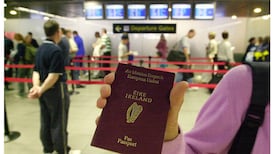One of the more striking features of the derelict buildings dotted around the south of Dublin city centre that were profiled in The Irish Times at the weekend was the number of them that had got snarled up in the planning process.
The appearance of six out of the 10 properties on the derelict sites register maintained by Dublin City Council could be attributed in part to the planning system.
Two houses on Sandwith Street Upper have lain empty for years as the O’Callaghan Hotel group sought to develop a larger site. Among the reason advanced by planners for opposing the original scheme was “loss of the original historic fabric” due to the demolition of five other vacant houses. The group subsequently lodged plans for a large-scale demolition and apartment development on the site, and in recent months has been granted permission for 82 apartments from three to 10 storeys.
Similarly, a row of houses on nearby Townsend St has been the subject of seven planning applications since 1999, three of which were approved, either directly or on appeal, but never went ahead. Among the issues identified by the planners with one of the proposals was “visual blight on a prominent inner-city corner”.
READ MORE
The owners of the Irish Yeast Company building at 6 College Street have made three unsuccessful planning applications since 2018, of which the last one was reversed on appeal by the then An Bord Pleanála. The planners’ objections included the risk that the development would “irreversibly” damage the historic premises.
And on it goes. An application to redevelop the Earl of Kildare Hotel at 47-49 Kildare St in 2019 was turned down. A renewed application was approved in 2023.
The City Arts Centre on Moss St has been vacant for two decades despite multiple attempts to redevelop it, including a 2022 application that would “seriously detract from the setting and character of the Custom House and environs”. Another application is live.
Then there is the Carrigan’s pub site at 73-74 Old Kilmainham. It is the subject of numerous applications, one of which was approved in 2007 but not acted on. A 2020 application was refused on the basis it would be over-development but successfully appealed to An Bord Pleanála.
Based on this small sample of the 130 derelict sites on the council’s list, one can posit that a potential solution to the issue of dereliction is for the owners of the properties to stop putting in planning applications that are out of context and doomed to failure, instead of working with the planners and get something built. A little less greed and bit more common sense? If that sounds naive, that is because it is naive.
There is a clear mismatch between what the owners of the sites want and what the city’s planners believe is appropriate. Developers will tell you that planners are idealistic and also unrealistic about what is commercially feasible given “real world” constraints such as costs, rents and all the other factors affecting “yield”. One of these factors is what people want. Usually, it is an affordable home rather than paying a premium to preserve the city’s architectural heritage. The planners will of course argue that someone must see the bigger picture and think long term. Their job is not to ensure the profitability of every scheme that comes before them.
These different objectives are not necessarily compatible but should be reconcilable, as is the case with most planning applications. Dublin’s derelict sites are, from one perspective, the product of occasions when they can’t be reconciled.
[ The Irish Times view on the planning system: proper resourcing is essentialOpens in new window ]
The hardest thing to understand about all this is why the owners of these sites keep coming forward with these apparently doomed applications.
Leaving aside the rights of the wrongs of the planners’ position – some might criticise their lack of ambition – they are a pretty predictable bunch. Their existing decisions should be a reasonably good indicator of what they will and won’t allow, and on what basis. This applies for derelict sites as much as anything else.
However, the attitude of the owners of these sites seems to be along the lines of “give it a lash and see what happens”. The rationale for lobbing in an application that, on the face of it, appears to have little chance of success is presumably that if you don’t ask, you won’t receive. It’s more of an opening gambit than a serious offer. It makes a certain amount of sense. The more you get in terms of density, the more money you make – and it’s worth the cost of several applications and an appeal to An Bord Pleanála.

Derelict Dublin: Why are there so many rotting buildings in the capital?
It may also be a case of necessity. What might have been a viable project when a site was acquired is no longer feasible as interest rates rise and costs escalate. You don’t have to look past the small sample of properties listed above to find examples of projects that did not go ahead once planning was eventually achieved, presumably because circumstances had changed.
Whatever the reason – be it greed, stupidity, desperation or a mixture of all three – this approach seems to be contributing to long delays, failed projects and a city centre blighted by derelict sites.














